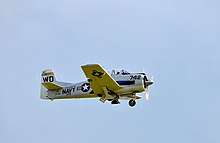North American T-28 Trojan
The North American Aviation T-28 Trojan is a piston-engined military trainer aircraft used by the United States Air Force and United States Navy beginning in the 1950s. Besides its use as a trainer, the T-28 was successfully employed as a counter-insurgency aircraft, primarily during the Vietnam War. It has continued in civilian use as an aerobatics and Warbird performer.
| T-28 Trojan | |
|---|---|
 | |
| A US Navy T-28B in 1973 | |
| Role | Trainer aircraft Light attack |
| Manufacturer | North American Aviation |
| First flight | 24 September 1949 |
| Retired | 1994 Philippine Air Force [1] |
| Primary users | United States Air Force United States Navy Republic of Vietnam Air Force French Air Force |
| Produced | 1950–1957 |
| Number built | 1,948 |
| Developed from | North American XSN2J |
| Developed into | AIDC T-CH-1 |
Design and development
On September 24, 1949, the XT-28 (company designation NA-159) was flown for the first time, designed to replace the T-6 Texan. The T-28A arrived at the Air Proving Ground, Eglin Air Force Base, Florida, in mid-June 1950, for suitability tests as an advanced trainer by the 3200th Fighter Test Squadron, with consideration given to its transition, instrument, and gunnery capabilities.[2] Found satisfactory, a contract was issued and between 1950 and 1957, a total of 1,948 were built.
Following the T-28's withdrawal from U.S. military service, a number were remanufactured by Hamilton Aircraft into two versions called the Nomair. The first refurbished machines, designated T-28R-1 were similar to the standard T-28s they were adapted from, and were supplied to the Brazilian Navy. Later, a more ambitious conversion was undertaken as the T-28R-2, which transformed the two-seat tandem aircraft into a five-seat cabin monoplane for general aviation use. Other civil conversions of ex-military T-28As were undertaken by PacAero as the Nomad Mark I and Nomad Mark II[3]
Operational history
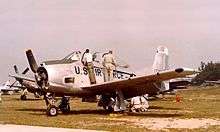
After becoming adopted as a primary trainer by the USAF, the United States Navy and Marine Corps adopted it as well. Although the Air Force phased out the aircraft from primary pilot training by the early 1960s, continuing use only for limited training of special operations aircrews and for primary training of select foreign military personnel, the aircraft continued to be used as a primary trainer by the Navy (and by default, the Marine Corps and Coast Guard) well into the early 1980s.
The largest single concentration of this aircraft was employed by the U.S. Navy at Naval Air Station Whiting Field in Milton, Florida, in the training of student naval aviators. The T-28's service career in the U.S. military ended with the completion of the phase-in of the T-34C turboprop trainer. The last U.S. Navy training squadron to fly the T-28 was VT-27 "Boomers", based at Naval Air Station Corpus Christi, Texas, flying the last T-28 training flight in early 1984. The last T-28 in the Training Command, BuNo 137796, departed for Naval District Washington on 14 March 1984 to be displayed permanently at Naval Support Facility Anacostia, D.C.[4]
Vietnam War combat

In 1963, a Royal Lao Air Force T-28 piloted by Lieutenant Chert Saibory, a Thai national, defected to North Vietnam. Saibory was immediately imprisoned and his aircraft was impounded. Within six months the T-28 was refurbished and commissioned into the North Vietnamese Air Force as its first fighter aircraft.[5]
T-28s were supplied to the Republic of Vietnam Air Force (RVNAF) in support of ARVN ground operations, seeing extensive service during the Vietnam War in RVNAF hands, as well as the Secret War in Laos. A T-28 Trojan was the first US fixed wing attack aircraft (non-transport type) lost in South Vietnam, during the Vietnam War. Capt. Robert L. Simpson, USAF, Detachment 2A, 1st Air Commando Group, and Lt. Hoa, RVNAF, were shot down by ground fire on August 28, 1962 while flying close air support. Neither crewman survived. The USAF lost 23 T-28s to all causes during the war, with the last two losses occurring in 1968.[6]
Other combat uses
T-28s were used by the CIA in the former Belgian Congo during the 1960s.[7]
France's Armée de l'Air used locally re-manufactured Trojans for close support missions in Algeria.[8]
Nicaragua replaced its fleet of 30+ ex-Swedish P-51s with T-28s in the early 1960s.
The Philippines utilized T-28s (colloquially known as "Tora-toras") during the 1989 Philippine coup attempt. The aircraft were often deployed as dive bombers by rebel forces.
Civilian use
AeroVironment modified and armored a T-28A to fly weather research for South Dakota School of Mines & Technology, funded by the National Science Foundation, and operated in this capacity from 1969 to 2005.[9][10] SDSM&T was planning to replace it with another modified, but more modern, former military aircraft, specifically a Fairchild Republic A-10 Thunderbolt II.[11] This plan was found to carry too many risks associated with the costly modifications required and the program was cancelled in 2018.[12]
Aerobatics and warbird display
Many retired T-28s were subsequently sold to private civil operators, and due to their reasonable operating costs are often found flying or displayed as warbirds today.
Variants
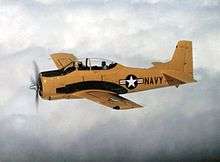
_1955.jpeg)
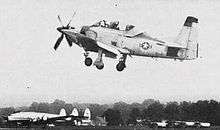
- XT-28
- Prototype; two built.
- T-28A
- U.S. Air Force version with an 800 hp (597 kW) Wright R-1300-7 radial engine; 1,194 built.
- T-28B
- U.S. Navy version with 1,425 hp (1,063 kW) Wright R-1820-86A or - 86B radial engine, three-blade propeller, belly-mounted speed brake; 489 built.
- T-28C
- U.S. Navy version, a T-28B with shortened propeller blades and tailhook for carrier-landing training; 266 built.
- T-28D Nomad
- T-28Bs converted for the USAF in 1962 for the counter-insurgency, reconnaissance, search and rescue, and forward air controller roles in Vietnam. Fitted with two underwing hardpoints. The later T-28D-5 had ammo pans inside the wings that could be hooked up to hardpoint-mounted gun pods for a better center of gravity and aerodynamics; 321 converted by Pacific Airmotive (Pac-Aero).
- Fairchild AT-28D
- Attack model of the T-28D used for Close Air Support (CAS) missions by the USAF and allied Air Forces in Southeast Asia, which were nicknamed "Tangos" by their pilots.[16] It was fitted with six underwing hardpoints and the rocket-powered Stanley Yankee ejection seat;[17][18] 72 converted by Fairchild Hiller.
- YAT-28E
- Experimental development of the counter-insurgency T-28D. It was powered by a 2,445 hp (1,823 kW) Lycoming YT-55L-9 turboprop, and armed with two .50 in machine guns and up to 6,000 lb (2,730 kg) of weapons on 12 underwing hardpoints. Three prototypes were converted from T-28As by North American, with the first model flying on 15 February 1963. The project was canceled in 1965.[19]
- T-28S Fennec
- Ex-USAF T-28As converted in 1959 for use by the French Armée de l'Air, replacing the Morane-Saulnier MS.733A. It was flown by their Escadrilles d'Aviation Légère d'Appui (EALA; "Light Aviation Support Squadrons") in the counter insurgency role in North Africa from 1959 to 1962. Fitted with an electrically powered sliding canopy, side-armor, a 1,200 hp Wright R-1820-97 supercharged radial engine (the model used in the B-17 bomber),[20] and four underwing hardpoints.[21] It is referred to as the "S" variant because its engine had a supercharger on it; it has also been referred to as the T-28F variant – with the "F" standing for France.
- For fire support missions it usually carried two double-mount .50-caliber machine gun pods (with 100 rounds per gun) and two MATRA Type 122 6 x 68mm rocket pods.[21] It could also carry on paired hardpoints a 120 kg.[264 lb.] HE or GP "iron" bomb, a MATRA Type 361 36 x 37mm [1.45-inch] rocket pod, a SNEB 7 x 55mm [2.16-inch] rocket pod, or a MATRA Type 13 single-rail, MATRA Type 20 or Type 21 double-rail, MATRA Type 41 quadruple-rail (2 x 2), or MATRA Type 61 or Type 63 sextuple-rail (3 x 3) SERAM T10 heavy rocket launchers.[21] Improvised napalm bombs (called bidons spéciaux, or "special cans") were created by dropping gas tanks loaded with octagel-thickened fuel inside, then later igniting or detonating the spilled fuel with white phosphorus rockets.[21]
- Total 148 airframes bought from Pacific Airmotive (Pac Aero) and modified by Sud-Aviation in France. After the war the French government offered them for sale from 1964 to 1967.[8] They sold most of them to Morocco and Argentina.[8] The Fuerza Aérea de Nicaragua (FAN) purchased four of these ex-Morocco aircraft during 1979. Argentina later sold some to Uruguay and Honduras.[8]
- T-28P
- T-28S Fennec aircraft sold to the Argentinian Navy as carrier-borne attack aircraft. They were given shortened propeller blades and a tailhook to allow carrier landings.[22]
- T-28R Nomair
An attempt by Hamilton Aircraft Company[23] of Tucson, Arizona to make a civilianized Nomad III-equivalent out of refurbished ex-USAF T-28As. It had a Wright Cyclone R-1820-80 engine to make it fast and powerful, but had to lengthen the wingspan by seven feet to reduce the stall speed to below a "street-legal" 70 knots.[15][24] The prototype flew for the first time in September, 1960, and the FAA Type Certificate was received on 15 February 1962.[24] At the time, the T-28-R2 was the fastest single-engined standard category aircraft available in the United States. It had been flown to a height of 38,700 ft. [11,800 m].
- T-28R-1 Nomair I
- A military trainer that had a tandem cockpit, dual instrumentation and flying controls, and hydraulically-actuated rearward-sliding canopy.[15][25] Six were sold in 1962 as carrier-landing trainers to the Brazilian Navy and were modified with a carrier arrestor hook. They were later transferred to the Brazilian Air Force.[24]
- T-28R-2 Nomair II
- Modified to have a cramped five-seater cabin (one pilot and two rows of two passengers) that opened from the port side.[15][25] Ten aircraft were modified in all; one was sold to a high-altitude photographic company.[24]
- RT-28
- Photo reconnaissance conversion for counter-insurgency use with Royal Lao Air Force. Number of conversions unknown.[26][27]
Operators
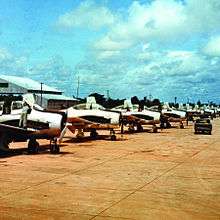

.jpg)
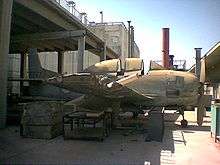
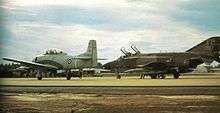

- Argentine Air Force - 34 T-28A[28][29]
- Argentine Naval Aviation.[29] 65 ex-French Air Force T-28S Fennec aircraft.[30][31] Last nine transferred to Uruguayan naval aviation in 1980.
- Bolivian Air Force at least six T-28Ds.[29][30][32]
- Brazilian Navy - 18 T-28C[29]
- Air Force of the Democratic Republic of the Congo - 14 T-28C, 3 T-28B, 10 T-28D[33]
- Ecuadorian Air Force - nine T-28A[29][37]
- Ethiopian Air Force - 12 T-28A and 12 T-28D[29][30][31][38]
- French Air Force - 148 T-28A airframes modified in France (1959) to make the T-28S Fennec COIN model.[31]
- Haitian Air Force - 12 ex-French Air Force[29]
- Honduran Air Force - eight former Moroccan Air Force Fennecs. One delivered, seven others impounded at Fort Lauderdale[30][31][39]
- Khmer Air Force operated 47 T-28s in total in service.[29][30][31]
- Royal Lao Air Force - 55 T-28D[29][30][31][42]
- Mexican Air Force - 32 T-28A[29][31][43]
- Royal Moroccan Air Force - 25 Fennec aircraft [29][30][31][39]
- Nicaraguan Air Force - six T-28D[29][31]
- Philippine Air Force - 12 T-28A[29][30][31][44]
- Royal Saudi Air Force - 25 T-28A
- Republic of Vietnam Air Force[31]
- Tunisian Air Force - Fennec[29]
- United States Army[48]
- United States Air Force - 1194 T-28A, of which 360 converted to "D"[29]
- United States Navy - 489 T-28B and 299 T-28C[29]
Surviving aircraft

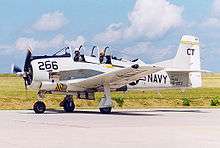
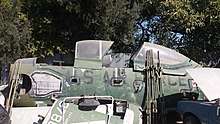
Many T-28s are on display throughout the world. In addition, a considerable number of flyable examples exist in private ownership, as the aircraft is a popular sport plane and warbird.
Argentina
- On display
- T-28A
- S/N 174112 (ex USAF 51-3574), formerly operated by the Argentine Air Force as E-608. Preserved at the Museo Regional Inter Fuerzas, Estancia Santa Romana, San Luis.[51]
- C/N° 174333 (ex-USAF 51-3795), formerly operated by the Argentine Naval Aviation. Preserved at the Argentine Naval Aviation Museum.[52]
Australia
- On display
- T-28A
- 49-1583 - Australian Aviation Museum, Bankstown Airport, New South Wales, Australia.[53]
BU Number 140016 is based in Perth at Jandakot Airport and owned by S&k Investments.
Thailand
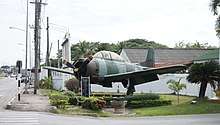
- On display
- T-28A
- 49-1538 - Prachuap Khiri Khan AFB in Bangkok, Thailand.[56]
- 49-1601 - Don Muang Royal Thai Air Force Base, Bangkok, Thailand.[57]
- 49-1687 - Loei Airport, Loei Province, Thailand.[58]
- 51-3480 - Udorn Royal Thai Air Force Base, Thailand.[59]
- 51-3578 - Chiang Mai AFB, Bangkok, Thailand.[60]
- 51-3740 - Don Muang Royal Thai Air Force Base, Bangkok, Thailand.[61]
- 153652 - National Memorial, Bangkok, Thailand.[62]
- T-28B
United Kingdom
- On display
- T-28C
- 146289 - Norfolk & Suffolk Aviation Museum, Flixton, The Saints, United Kingdom.[67]
United States
- On display
- T-28A
- 49-1494 - National Museum of the United States Air Force at Wright-Patterson AFB in Dayton, Ohio. The aircraft is painted as a typical Air Training Command T-28A of the mid-1950s. It was transferred to the museum in September 1965. It is on display in the museum's Cold War Gallery.[68]
- 49-1663 - Hurlburt Field, Florida.[69]
- 49-1679 - Reese AFB, Texas.[70]
- 49-1682 - Laughlin AFB, Texas.[71]
- 49-1689 - Vance AFB, Oklahoma.[72]
- 49-1695 - Randolph AFB, Texas.[73]
- 50-0300 - Dakota Territory Air Museum, Minot, North Dakota.[74]
- 51-3612 - Museum of Aviation, Robins Air Force Base, Warner Robins, Georgia.[75]
- 51-7500 - Olympic Flight Museum, Olympia, Washington.[76]
- T-28B

- 137702 - Air Force Flight Test Center Museum, Edwards AFB, California.[77]
- 137749 - Hill Aerospace Museum, Hill Air Force Base, Utah
- 137796 - Naval Air Station Anacostia, Washington, DC.[78]
- 138144 - Naval Air Station Whiting Field, Florida.[79]
- 138164 - Actively flying and performing in airshows with the Trojan Phlyers in Dallas, TX.[80]
- 138192 - Aviation Heritage Center of Wisconsin, Sheboygan Memorial Airport, Sheboygan, WI[81]
- 138247 - War Eagles Air Museum in Santa Teresa, New Mexico.[82]
- 138326 - National Naval Aviation Museum, Naval Air Station Pensacola, Florida[83]
- 138339 - Owned by Skydoc 1989-present (2019) Springfield, Illinois performing with the Trojan Horsemen 2003-2017, and Trojan Thunder 2017-present.[84]
- 138353 - on a pole at Milton, Florida.[85]
- 140047 - Actively flying and performing in airshows with the Trojan Phlyers in Dallas, TX.[80]
- 140048 - National Museum of the United States Air Force at Wright-Patterson AFB in Dayton, Ohio.[86]
- T-28C
- 138245 - WarBird Museum of Virginia in Chesterfield, Virginia.[87]
- 140451 - Middleton Field in Evergreen, Alabama
- 140454 - Battleship Cove in Fall River, Massachusetts.[88]
- 140481 - Pima Air & Space Museum adjacent to Davis-Monthan AFB in Tucson, Arizona.[89]
- 140557 - Naval Air Station Wildwood Aviation Museum, Cape May Airport, Rio Grande, New Jersey.[90]
- 140659 - Southern Museum of Flight, Birmingham, Alabama.[91]
- YAT-28E
- 0-13786 - Private collection, Port Hueneme, California. One of two surviving air-frames, currently in storage awaiting restoration.[92]
Specifications (T-28D)
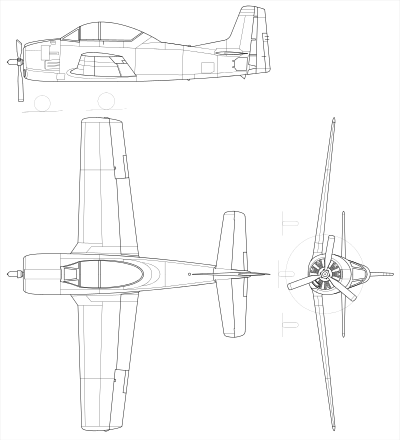
Data from Encyclopedia of World Military Aircraft[93]
General characteristics
- Crew: 2
- Length: 33 ft 0 in (10.06 m)
- Wingspan: 40 ft 1 in (12.22 m)
- Height: 12 ft 8 in (3.86 m)
- Wing area: 268.0 sq ft (24.90 m2)
- Aspect ratio: 6.0:1
- Empty weight: 6,424 lb (2,914 kg) (equipped)
- Max takeoff weight: 8,500 lb (3,856 kg)
- Powerplant: 1 × Wright R-1820-86 Cyclone 9-cylinder air-cooled radial engine, 1,425 hp (1,063 kW)
Performance
- Maximum speed: 343 mph (552 km/h, 298 kn) at 10,000 ft (3,000 m)
- Ferry range: 1,060 mi (1,710 km, 920 nmi)
- Service ceiling: 35,500 ft (10,800 m)
- Rate of climb: 3,540 ft/min (18.0 m/s)
Armament
- Hardpoints: 6 with a capacity of 1,200 lb (540 kg) total,
See also
Related development
Aircraft of comparable role, configuration and era
Related lists
References
Notes
- "Historical Listings: Philippines, (PHL)." Archived 2011-07-20 at the Wayback Machine World Air Forces. Retrieved: 19 May 2011.
- Fort Walton, Florida, "T-28 Trainer Now at Eglin – Is Latest Word In Instructional Craft", Playground News, 22 June 1950, Vol. 5, No. 21, p. 10.
- The Illustrated Encyclopedia of Aircraft 1985, p. 2678.
- "T-28." history.navy.mil. Retrieved: 9 July 2010.
- Toperczer 2001, pp. 8–9.
- Hobson 2001, p. 12.
- Holm, Richard L. "A Plane Crash, Rescue, and Recovery - A Close Call in Africa". Center for the Study of Intelligence, Historical Perspectives, Washington, D.C., Winter 1999-2000.
- Ganivet, Jean-Luc. "T-28 Fennec History." fennec.pfiquet. Retrieved: 31 December 2013.
- Godfrey, Joe. "Charlie Summers" AVweb, 16 April 2003. Retrieved: 22 July 2012.
- "T-28 Instrumented Research Aircraft" South Dakota School of Mines & Technology. Retrieved: 22 July 2012.
- "Next-generation Storm-penetrating Aircraft" (PDF). South Dakota School of Mines and Technology. Retrieved 14 December 2013.
- Rogoway, Tyler. "The Storm Chasing A-10 Thunderhog Program Is Officially Dead, Jet To Be Returned To USAF". The Drive. Retrieved 2018-10-13.
- See German Wikipedia Flugplatz Albstadt-Degerfeld
- Sweeney, Richard L. "New Role for Nomad."Flying Magazine, December 1961.
- Concannon, Milt. "The Lost (and last) Nomad." Archived 2014-01-01 at the Wayback Machine courtesyaircraft.com. Retrieved: December 31, 2013.
- Trichter, J. Gary. "The Poor Man's P-51: The T-28 Trojan". Retrieved 2019-07-12.
- "Roden 1/48 AT-28D Trojan." modelingmadness.com. Retrieved: 31 December 2013.
- "The Ejection Site: Stanley YANKEE Extraction System". www.ejectionsite.com.
- Tate Air Enthusiast May/June 1999, pp. 58–59.
- "Warbirds of New Smyrna." angelfire.com, p. 44. Retrieved: 31 December 2013.
- Renaud, Patrick-Charles."Aerostories (Algérie (1954-1962): T-28 Fennec: des ailes pour un renard." aerostories, 2002. Retrieved: 31 December 2013.
- North American T-28 Trojan/Fennec in Argentina
- "HAMILTON AIRCRAFT COMPANY INC". www.aviastar.org.
- "Hamilton T-28-R2 Nomair (N9106Z)". Ron Dupas Collection, No. 1040, August 1970. Retrieved: 31 December 2013.
- Flying Magazine, April 1962, p. 3.
- Troung, Albert Grandolini and Tom Cooper. "Laos, 1948-1989; Part 1." Indochina Database, 13 November 2003. Retrieved: 17 April 2012.
- Troung, Albert Grandolini and Tom Cooper. "Laos, 1948-1989; Part 2." Indochina Database, 13 November 2003. Retrieved: 17 April 2012.
- Ay, Carlos. "The Illustrated Catalogue to Argentine Air Force Aircraft." Aeromilitaria, 15 August 2013. Retrieved: 31 December 2013.
- Taylor and Munson 1973, p. 179.
- Krivinyi 1977, p. 178.
- Fitzsimons 1988, p. 137.
- Andrade 1982, p. 28.
- Air-Britain Aeromilitaria, March 2015
- Wieland, William A. "Memorandum From the Director of the Office of Middle American Affairs." latinamericanstudies.org, August 1958. Retrieved: 21 February 2010.
- Valero, Jose Ramon. "Picture of the North American T-28 Trojan aircraft." airliners.net, October 2003. Retrieved: 21 February 2010.
- Andrade 1982, p. 56.
- Andrade 1982, p. 58.
- Andrade 1982, p. 62.
- Andrade 1982, p. 97.
- Green 1956, p. 238.
- Thompson, Paul North American T-28D Trojan J-HangarSpace Retrieved August 18, 2017
- Andrade 1982, p. 146.
- Andrade 1982, p. 156.
- Andrade 1982, p. 181.
- Andrade 1982, p. 143.
- Andrade 1982, p. 223.
- Pocock 1986, p. 115.
- "Talking Paper for Chief of Staff, U.S. Army: Guidance for T-28 Aircraft Operations." U.S. Army, 9 March 1964.
- Andrade 1982, p. 336.
- Secrets of US Air Operations in North Vietnam (Bí mật các chiến dịch không kích của Mỹ vào Bắc Việt Nam (in Vietnamese)). Hanoi: People's Police Publisher, p. 513.
- Aviacion Militar Argentina (Amilarg)- North American T-28A/F/P Trojan/Fennec (retrieved 2014-11-23) Archived 2014-11-29 at the Wayback Machine
- Museo de la Aviacion Naval - ARA 25 de MAYO - T-28 Fennec (retrieved 2014-08-19) Archived 2008-10-04 at the Wayback Machine
- "T-28 Trojan/49-1583." Warbird Registry. Retrieved: 11 June 2012.
- "T-28 Trojan/140533." Warbird Registry. Retrieved: 11 June 2012.
- "T-28 Trojan/51-3664." Warbird Registry. Retrieved: 11 June 2012.
- "T-28 Trojan/49-1538." Warbird Registry. Retrieved: 11 June 2012.
- "T-28 Trojan/49-1601." Warbird Registry. Retrieved: 11 June 2012.
- "T-28 Trojan/49-1687." Warbird Registry. Retrieved: 11 June 2012.
- "T-28 Trojan/51-3480." Warbird Registry. Retrieved: 11 June 2012.
- "T-28 Trojan/51-3578." Warbird Registry. Retrieved: 11 June 2012.
- "T-28 Trojan/51-3740." Warbird Registry. Retrieved: 11 June 2012.
- "T-28 Trojan/153652" Warbird Registry. Retrieved: 11 June 2012.
- "T-28 Trojan/137661." Warbird Registry. Retrieved: 11 June 2012.
- "T-28 Trojan/138157." Warbird Registry. Retrieved: 11 June 2012.
- "T-28 Trojan/138284." Warbird Registry. Retrieved: 11 June 2012.
- "T-28 Trojan/138302." Warbird Registry. Retrieved: 11 June 2012.
- "T-28 Trojan/146289." Warbird Registry. Retrieved: 11 June 2012.
- "T-28 Trojan/49-1494." Warbird Registry. Retrieved: 11 June 2012.
- "T-28 Trojan/49-1663." Warbird Registry. Retrieved: 11 June 2012.
- "T-28 Trojan/49-1679." Warbird Registry. Retrieved: 11 June 2012.
- "T-28 Trojan/49-1682." Warbird Registry. Retrieved: 11 June 2012.
- "T-28 Trojan/49-1689." Warbird Registry. Retrieved: 11 June 2012.
- "T-28 Trojan/49-1695." Warbird Registry. Retrieved: 11 June 2012.
- "T-28 Trojan/50-0300." Warbird Registry. Retrieved: 11 June 2012.
- "T-28 Trojan/51-3612." Warbird Registry. Retrieved: 11 June 2012.
- "T-28 Trojan/51-7500." Warbird Registry. Retrieved: 11 June 2012.
- "T-28 Trojan/137702." Warbird Registry. Retrieved: 11 June 2012.
- "T-28 Trojan/137796." Warbird Registry. Retrieved: 11 June 2012.
- "T-28 Trojan/138144." Warbird Registry. Retrieved: 11 June 2012.
- "Trojan Phlyer's T28s".
- "US Navy and US Marine Corps BuNos--Third Series (135774 to 140052)". www.joebaugher.com. Retrieved 2017-05-15.
- "T-28 Trojan/138247." Warbird Registry. Retrieved: 11 June 2012.
- < "Aircraft on Display: T-28." Naval Aviation Museum. Retrieved: 31 December 2013.
- "T-28 Trojan/138339." trojanhorsemen.com. Retrieved: 22 March 2013.
- "T-28 Trojan/138353." Warbird Registry. Retrieved: 11 June 2012.
- "T-28 Trojan/140048." Warbird Registry. Retrieved: 11 June 2012.
- "WarBird Museum of Virginia". warbirdmuseumva.org.
- "T-28 Trojan/140454." Warbird Registry. Retrieved: 11 June 2012.
- "T-28 Trojan/140481." Warbird Registry. Retrieved: 11 June 2012.
- "T-28 Trojan/140557." Warbird Registry. Retrieved: 11 June 2012.
- "T-28 Trojan/140659." Warbird Registry. Retrieved: 11 June 2012.
- "YAT-28E". Helen Murphy.
- Donald and Lake 1996, p. 333
Bibliography
- Andrade, John. Militair 1982. London: Aviation Press Limited, 1982. ISBN 0-907898-01-7.
- Avery, Norm. North American Aircraft: 1934–1998, Volume 1. Santa Ana, California: Narkiewicz-Thompson, 1998. ISBN 0-913322-05-9.
- Compton, Frank. "November 79 Zulu: the Story of the North American Nomad". Sport Aviation, June 1983.
- Donald, David and Lake, Jon. Encyclopedia of World Military Aircraft. London:Aerospace Publishing, 1996. ISBN 1-874023-95-6.
- Fitzsimons, Bernie. The Defenders: A Comprehensive Guide to Warplanes of the USA. London: Aerospace Publishing, 1988. ISBN 0-8317-2181-2.
- Green, William. Observers Aircraft, 1956. London: Frederick Warne Publishing, 1956.
- Hobson, Chris. Vietnam Air Losses, USAF/Navy/Marine, Fixed Wing Aircraft Losses in Southeast 1961–1973. North Branch, Minnesota: Specialty Press, 2001. ISBN 1-85780-115-6.
- The Illustrated Encyclopedia of Aircraft (Part Work 1982–1985). London: Orbis Publishing, 1985.
- Krivinyi, Nikolaus. World Military Aviation. New York: Arco Publishing Company, 1977. ISBN 0-668-04348-2.
- Pocock, Chris. "Thailand Hones its Air Forces". Air International, Vol. 31, No. 3, September 1986. pp. 113–121, 168. ISSN 0306-5634.
- Tate, Jess. "Ultimate Trojan: North American's YAT-28E Project". Air Enthusiast, No. 99, May/June 1999. pp. 58–59. ISSN 0143-5450.
- Taylor, John J.H. and Kenneth Munson.Jane's Pocket Book of Major Combat Aircraft. New York: Collier Books, 1973. ISBN 0-7232-3697-6.
- Thompson, Kevin. North American Aircraft: 1934–1998 Volume 2. Santa Ana, California: Narkiewicz-Thompson, 1999. ISBN 0-913322-06-7.
- Toperczer, Istvan. MiG-17 and MiG-19 Units of the Vietnam War. London: Osprey Publishing Limited, 2001. ISBN 1-84176-162-1.
- United States Air Force Museum Guidebook. Wright-Patterson AFB, Ohio: Air Force Museum Foundation, 1975.
Further reading
- Adcock, Al. T-28 Trojan in Action. Squadron/Signal Publications Inc. 1989. ISBN 0-89747-211-X
- Genat, Robert. "Final Tour of Duty - North American's T-28 Trojans". North Branch, Minnesota: Specialty Press, 1996. ISBN 0-933424-61-2
- Ginter, Steve (1981). North American T-28 Trojan. Naval Fighters. Nº5 (First ed.). California, United States: Ginter Books. ISBN 0-942612-05-1. Retrieved 31 January 2015.
- Núñez Padin, Jorge Felix (2010). Núñez Padin, Jorge Felix (ed.). North American T-28 Fennec. Serie Aeronaval (in Spanish). 28. Bahía Blanca, Argentina: Fuerzas Aeronavales. ISBN 978-987-1682-02-7. Archived from the original on 2015-09-24. Retrieved 2014-08-21.
External links
| Wikimedia Commons has media related to T-28 Trojan. |
